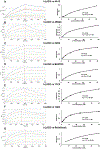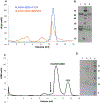Epitope Mapping of Therapeutic Antibodies Targeting Human LAG3
- PMID: 36104110
- PMCID: PMC9696730
- DOI: 10.4049/jimmunol.2200309
Epitope Mapping of Therapeutic Antibodies Targeting Human LAG3
Abstract
Lymphocyte activation gene 3 protein (LAG3; CD223) is an inhibitory receptor that is highly upregulated on exhausted T cells in tumors and chronic viral infection. Consequently, LAG3 is now a major immunotherapeutic target for the treatment of cancer, and many mAbs against human (h) LAG3 (hLAG3) have been generated to block its inhibitory activity. However, little or no information is available on the epitopes they recognize. We selected a panel of seven therapeutic mAbs from the patent literature for detailed characterization. These mAbs were expressed as Fab or single-chain variable fragments and shown to bind hLAG3 with nanomolar affinities, as measured by biolayer interferometry. Using competitive binding assays, we found that the seven mAbs recognize four distinct epitopes on hLAG3. To localize the epitopes, we carried out epitope mapping using chimeras between hLAG3 and mouse LAG3. All seven mAbs are directed against the first Ig-like domain (D1) of hLAG3, despite their different origins. Three mAbs almost exclusively target a unique 30-residue loop of D1 that forms at least part of the putative binding site for MHC class II, whereas four mainly recognize D1 determinants outside this loop. However, because all the mAbs block binding of hLAG3 to MHC class II, each of the epitopes they recognize must at least partially overlap the MHC class II binding site.
Copyright © 2022 by The American Association of Immunologists, Inc.
Figures





Similar articles
-
[Preparation and identification of monoclonal antibodies against human LAG3 by immunizing mice with recombinant eukaryotic cell antigens].Xi Bao Yu Fen Zi Mian Yi Xue Za Zhi. 2024 Dec;40(12):1110-1114. Xi Bao Yu Fen Zi Mian Yi Xue Za Zhi. 2024. PMID: 39750049 Chinese.
-
The immune checkpoint receptor LAG3: Structure, function, and target for cancer immunotherapy.J Biol Chem. 2024 May;300(5):107241. doi: 10.1016/j.jbc.2024.107241. Epub 2024 Mar 30. J Biol Chem. 2024. PMID: 38556085 Free PMC article. Review.
-
Lymphocyte activation gene 3: a novel therapeutic target in chronic lymphocytic leukemia.Haematologica. 2017 May;102(5):874-882. doi: 10.3324/haematol.2016.148965. Epub 2017 Feb 2. Haematologica. 2017. PMID: 28154084 Free PMC article.
-
A novel LAG3 neutralizing antibody improves cancer immunotherapy by dual inhibition of MHC-II and FGL1 ligand binding.Biomed Pharmacother. 2024 Jun;175:116782. doi: 10.1016/j.biopha.2024.116782. Epub 2024 May 21. Biomed Pharmacother. 2024. PMID: 38776682
-
LAG3 (CD223) as a cancer immunotherapy target.Immunol Rev. 2017 Mar;276(1):80-96. doi: 10.1111/imr.12519. Immunol Rev. 2017. PMID: 28258692 Free PMC article. Review.
Cited by
-
Structural insights reveal interplay between LAG-3 homodimerization, ligand binding, and function.Proc Natl Acad Sci U S A. 2024 Mar 19;121(12):e2310866121. doi: 10.1073/pnas.2310866121. Epub 2024 Mar 14. Proc Natl Acad Sci U S A. 2024. PMID: 38483996 Free PMC article.
-
Advances in LAG3 cancer immunotherapeutics.Trends Cancer. 2025 Jan;11(1):37-48. doi: 10.1016/j.trecan.2024.10.009. Epub 2024 Nov 26. Trends Cancer. 2025. PMID: 39603977 Free PMC article. Review.
-
LAG Time in the Era of Immunotherapy-New Molecular Insights Into the Immunosuppression Mechanism of Lymphocyte Activation Gene-3.Immunol Rev. 2025 Mar;330(1):e70002. doi: 10.1111/imr.70002. Immunol Rev. 2025. PMID: 39887765 Review.
-
CryoEM structure of a therapeutic antibody (favezelimab) bound to human LAG3 determined using a bivalent Fab as fiducial marker.Structure. 2023 Oct 5;31(10):1149-1157.e3. doi: 10.1016/j.str.2023.07.013. Epub 2023 Aug 23. Structure. 2023. PMID: 37619561 Free PMC article.
-
Structural basis for mouse LAG3 interactions with the MHC class II molecule I-Ab.Nat Commun. 2024 Aug 29;15(1):7513. doi: 10.1038/s41467-024-51930-5. Nat Commun. 2024. PMID: 39209860 Free PMC article.
References
-
- Larkin J, Chiarion-Sileni V, Gonzalez R, Grob JJ, Rutkowski P, Lao CD, Cowey CL, Schadendorf D, Wagstaff J, Dummer R, et al. 2019. Five-year survival with combined nivolumab and ipilimumab in advanced melanoma. N. Engl. J. Med 381: 1535–1546. - PubMed
Publication types
MeSH terms
Substances
Grants and funding
LinkOut - more resources
Full Text Sources
Research Materials

